Creamy Pasta with Koji Amazake: A Recipe by Enomoto Misa
Apr 06,2023
Creamy Pasta with Koji Amazake: A Recipe by Enomoto Misa
Apr 06,2023
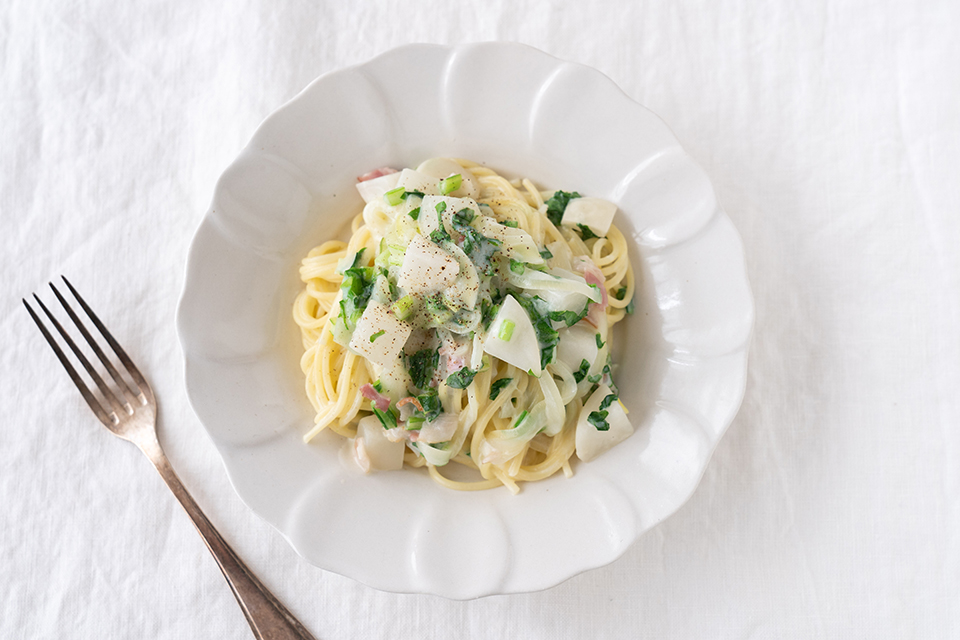

Japan abounds in fermented foods and condiments like miso, soy sauce, and vinegar. They’re part and parcel of Japanese life. Another example is the sweet fermented beverage koji amazake. Made with rice koji (malt), this can be used as a condiment to sweeten and enrich food.
For this article I interviewed culinary expert Enomoto Misa. Her recipes featuring seasonal vegetables and fermented foods like miso and salted koji have appeared on numerous media platforms. I visited her home the other day when spring was in the air, and she shared a recipe of hers made with koji amazake and spring vegetables.
Before we got to the recipe, I asked Misa what makes fermented foods so special.
Misa says she first cottoned on to the wonders of fermented foods back when she was a busy office worker.

“I’ve always loved miso soup. I love it so much, in fact, that I took some to the office every day. Those were hectic times, but I never fell seriously ill. I figure that all that miso soup was the reason. Then I gradually started using miso in my cooking and making dishes with various fermented foods like salted koji and koji amazake.”
Misa soon found herself captivated by the fine flavor of fermented foods.
“Eating fermented foods makes you feel in great condition. You feel like your gut is in better condition, and so is your skin. Eating something fermented today won’t lead to an immediate improvement tomorrow, but I’m convinced from experience that it’s good for you. That’s one of the great things about fermented foods.
“But if you were to ask me what’s the best thing about fermented foods, I would say the taste. Fermented foods taste great in their own right, and they make other foods taste better as well. They add umami and sweetness to vegetables and tenderize meat and fish. Now that’s just amazing.”

Having a baby further convinced Misa of the convenience and versatility of fermented foods.
“My little one has only just started eating baby food, and I wanted to choose something I absolutely knew was safe to eat. Well, koji amazake fits the bill. It’s a really handy fermented product. It can be used to make baby food or drunk as it is. I figure its mildly sweet taste must appeal to kids as well.
“Fermented foods are extremely attractive for a mother bringing up a child. With a great-tasting miso, you can make instant miso soup just by pouring hot water over it. Simply adding salted koji or onion koji to a soup enhances its flavor. Thanks to fermented foods, it takes just a few quick steps to make something that tastes delicious and is easy on the stomach. They’re a real lifesaver.”

Misa uses many different fermented foods in her everyday cooking. On my visit she shared a recipe featuring Plus Koji Koji-Amazake.
“Today I’m going to prepare a recipe made with spring turnips, which are tender and delicious at this time of year,” Misa explained. “Using koji amazake results in a great-tasting dish perfect for spring, though it’s simple enough.”

【2】Heat the olive oil in a frying pan over medium flame. Sauté the onion and bacon.
Once they become soft, add the turnip and flour and continue sautéing.
★HINT:Adding the flour at this point yields a nice light cream, eliminating the need to make white sauce.
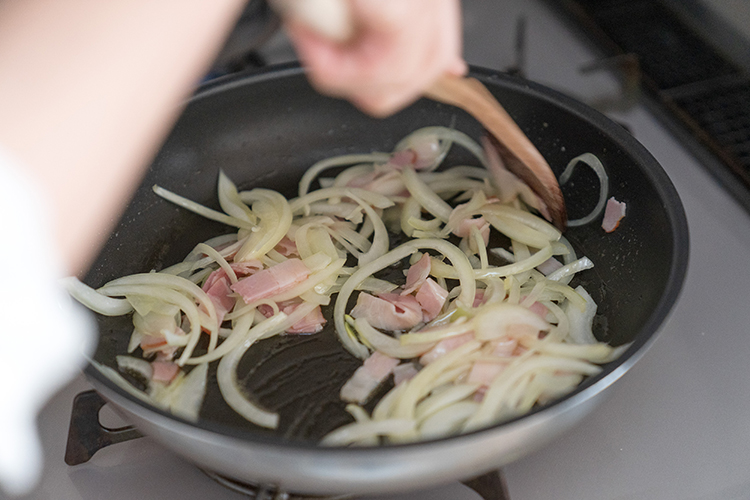
【3】When no longer floury, gradually add the milk and amazake.
Then add the salt and turnip leaves. Heat until the mixture thickens.
★HINT:When adding the milk and amazake, add it extra slowly at first so the flour doesn’t form lumps.

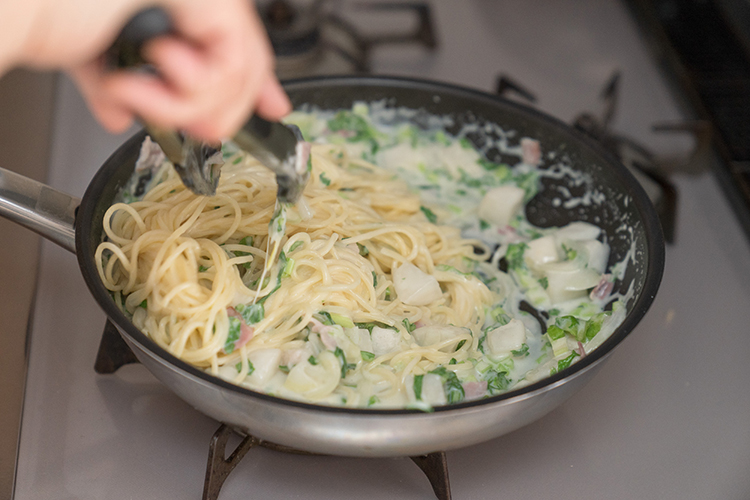
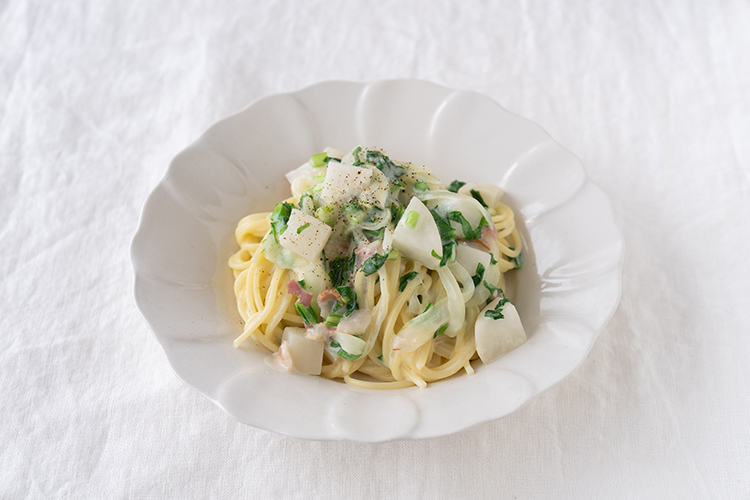
“The mild sweetness of koji amazake goes extremely well with spring vegetables, which have a faintly bitter flavor. This dish also tastes delicious made with greens like asparagus or rape in place of turnips. In this recipe I’ve let nothing go to waste. Even all the turnip leaves, which are high in nutrition, are added.”
Misa realized how well koji amazake went with spring vegetables, she says, when she tried using it in a spring cabbage soup. She’d combined it with meat and fish before, and she was fond of using it for beverages and confections. But pairing it with spring vegetables was a new discovery for her.
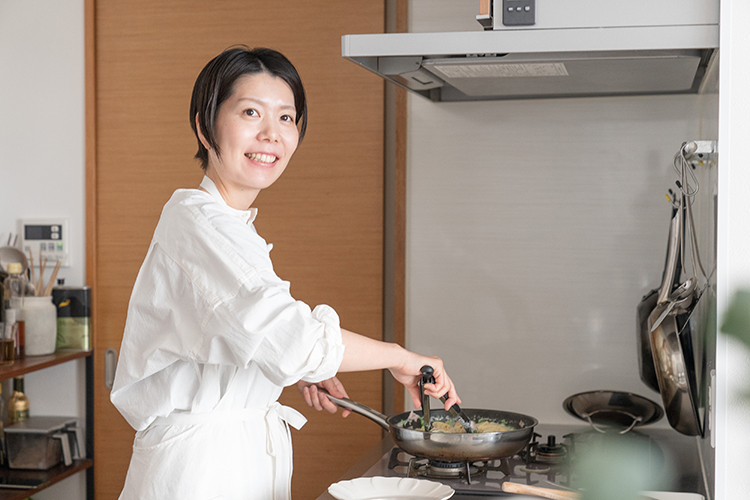
“Koji amazake doesn’t just go well with spring vegetables, of course. In winter, you can replace them with napa cabbage and increase the amount of koji amazake to create a slightly thicker sauce, which tastes equally good. Use whatever vegetables are in season, and have fun creating your own variations on this recipe.”
Misa’s home is well stocked with fermented foods, including miso and salted koji she’s made herself. She talked about the delights of making fermented foods at home.
“The flavor of fermented foods varies depending on when they’re made, who they’re made by, and the ingredients used. That’s why you develop an affection for fermented foods you make yourself. It’s such fun to create your own taste of home.
“We make miso every year. My husband and I each ferment a batch. It’s so neat how miso varies in taste even when it’s made identically. When my little one gets older, I hope to get them to make their own miso as well. Then we can taste and compare.”
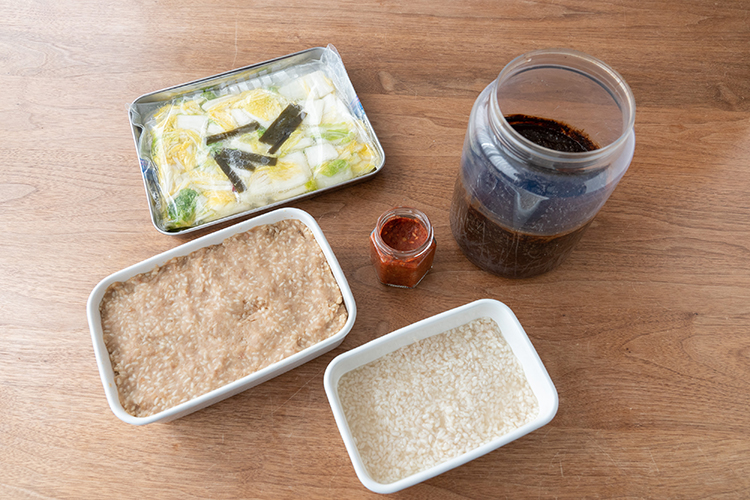
Misa makes a wide variety of fermented foods at home: salted koji, miso, fermented napa cabbage, Chinese chili bean sauce, soy sauce, and more.
But, adds Misa, “if you feel it’s too much work to make your own fermented food, it’s fine to use the stuff sold in stores. The truly important thing is making fermented foods a part of your daily routine.” Many people are daunted by the prospect of using fermented foods themselves. There’s still this perception that they’re only for true aficionados. Misa wants to convince people that in fact, that’s not the case.

“Salted koji, for example, can be used just like salt, and amazake serves as substitute sweetener. It’s really simple to incorporate fermented foods into your life when you give it a try. That’s what inspired me to write my books Miso Fermented Overnight and Fermenting the Laid-back Way.
“I don’t just use koji amazake in my cooking. I drink half a cup of it every morning with a teaspoon of kurozu (Japanese black vinegar). It’s simple, delicious, and wonderfully refreshing. I hope you’ll find it equally easy to incorporate fermented foods into your daily routine.”
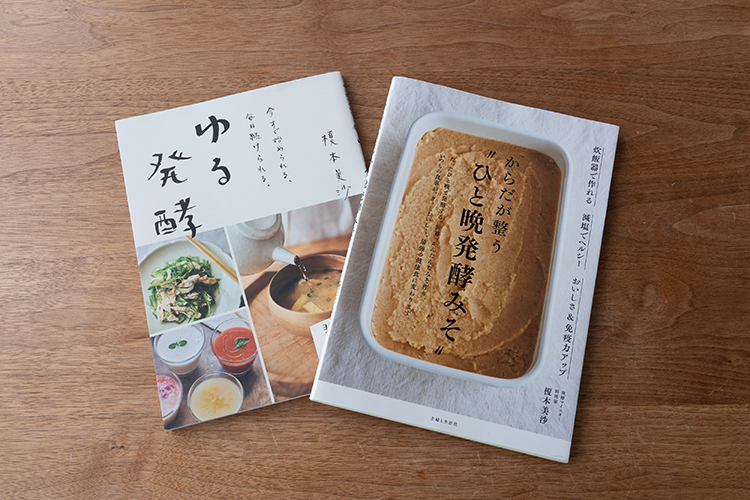
Misa’s books Fermenting the Laid-back Way and Miso Fermented Overnight for a Healthier You.
Both are packed with creative ideas on how to make fermented foods part of your life.
Misa wants to keep offering suggestions to that end.
“I’m not very adroit. From the time I was a little girl, I would try to do everything all at once, but nothing ever went right. Only when I became an adult did it occur to me that I should just keep it simple. As long as I did that, I figured, I should find things a lot easier. That thinking is mirrored in my recipes. Taking simple dishes and incorporating fermented foods into them makes them taste better and is emotionally rewarding. I plan to keep creating recipes that are a pleasure to make.
“At the same time, I hope to come up with eye-opening new ideas for fermented foods and how to combine them. After all, when it comes to fermented foods, there’s a lot more than meets the eye.”

Culinary expert and fermentation master
Culinary expert and fermentation master
Enomoto Misa is renowned for her no-nonsense recipes made with fermented foods and seasonal vegetables. She develops recipes for television, books, and magazines and frequently speaks at events. Her YouTube channel “Enomoto Misa’s Seasonal Cooking” has over 250,000 subscribers, and she’s also a hit on Instagram (@misa_enomoto). Her most recent book, Beginners Guide to Working with Ume (published by Yama-Kei Publishers), appeared in April 2023. She is also the author of Fermenting the Laid-back Way (published by Orangepage) and Miso Fermented Overnight for a Healthier You (published by Shufu to Seikatsu Sha).
●Youtube
https://www.youtube.com/channel/UCGiEIACoA-INiZuSFhoksYA
●instagram
https://www.instagram.com/misa_enomoto/